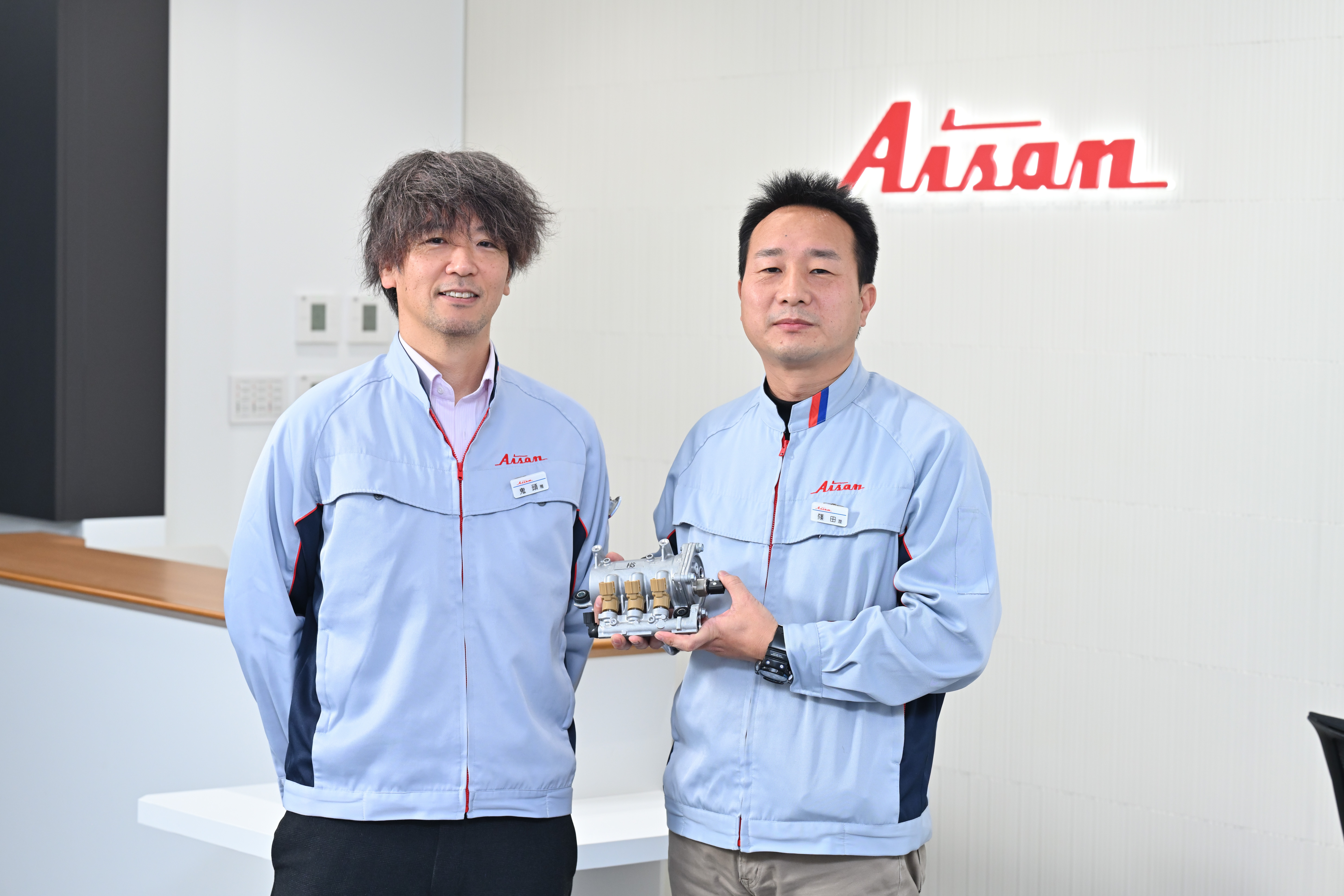Established a new technique through joint research that other manufacturers have not been able to replicate. Onto commercialization
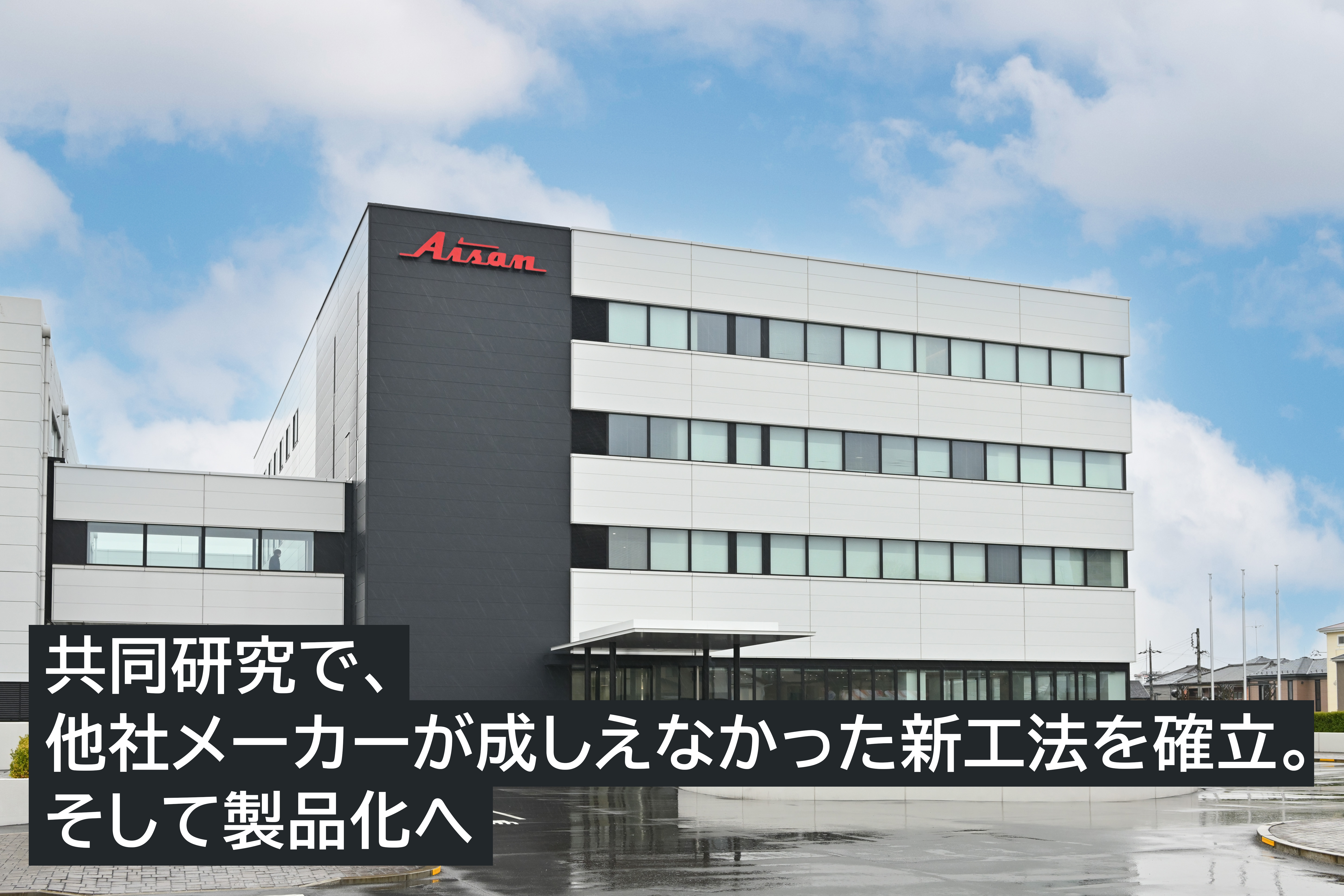
【Who we interviewed】
Aisan Industry Co., Ltd.
Masayuki Kito, Manager, Elemental Development Office, Machinery & Production Technology Development Department
Junichi Shinoda, Group Manager, Anjo No. 1 Production Technology Office, Core Products Production Technology Department
Aisan Industry Co., Ltd., (hereinafter referred to as “Aisan Industry”) is a company that develops, designs, and manufactures engine peripheral parts for automobiles. Headquartered in Aichi Prefecture, this company supplies products to meet the needs of Toyota and various other automobile manufacturers. As part of its operations, the company also proactively engages in research and development work on new products and techniques. Since 2011, it has been carrying out joint research with the National Institute of Advanced Industrial Science and Technology (hereinafter referred to as “AIST”) through a priority research project hosted by Knowledge Hub Aichi, a hub of research and development based in Aichi Prefecture. This has resulted in the establishment of a semisolid die-casting technique for a material known as ADC12 alloy and the development of a hydrogen supply unit for use with fuel cells as a system for supplying hydrogen in fuel cell electric vehicles (FCEVs).
An FCEV generates electricity through a chemical reaction between hydrogen and oxygen in the air; the resulting electricity is used to power the drive motor. Water is the only waste product that is emitted, which means that no carbon dioxide or other environmentally hazardous substances are produced. For this reason, FCEVs are expected to become increasingly popular as an environmentally friendly, sustainable motor vehicle option on the market.
In addition to Aisan Industry, various automobile manufacturers and parts manufacturers had been working on establishing a semisolid die-casting technique for the ADC12 alloy, but success was beyond the reach of everyone operating in this field. So how did Aisan Industry and AIST succeed? We sat down with Aisan Industry’s Masayuki Kito and Junichi Shinoda, who were involved in this joint research project, to find out more about what led to their company’s collaboration with AIST, the results that were obtained through this collaboration, the subsequent use of this technology, and other topics in detail.
Taking on the challenge of developing technology that is widely sought in the world at large
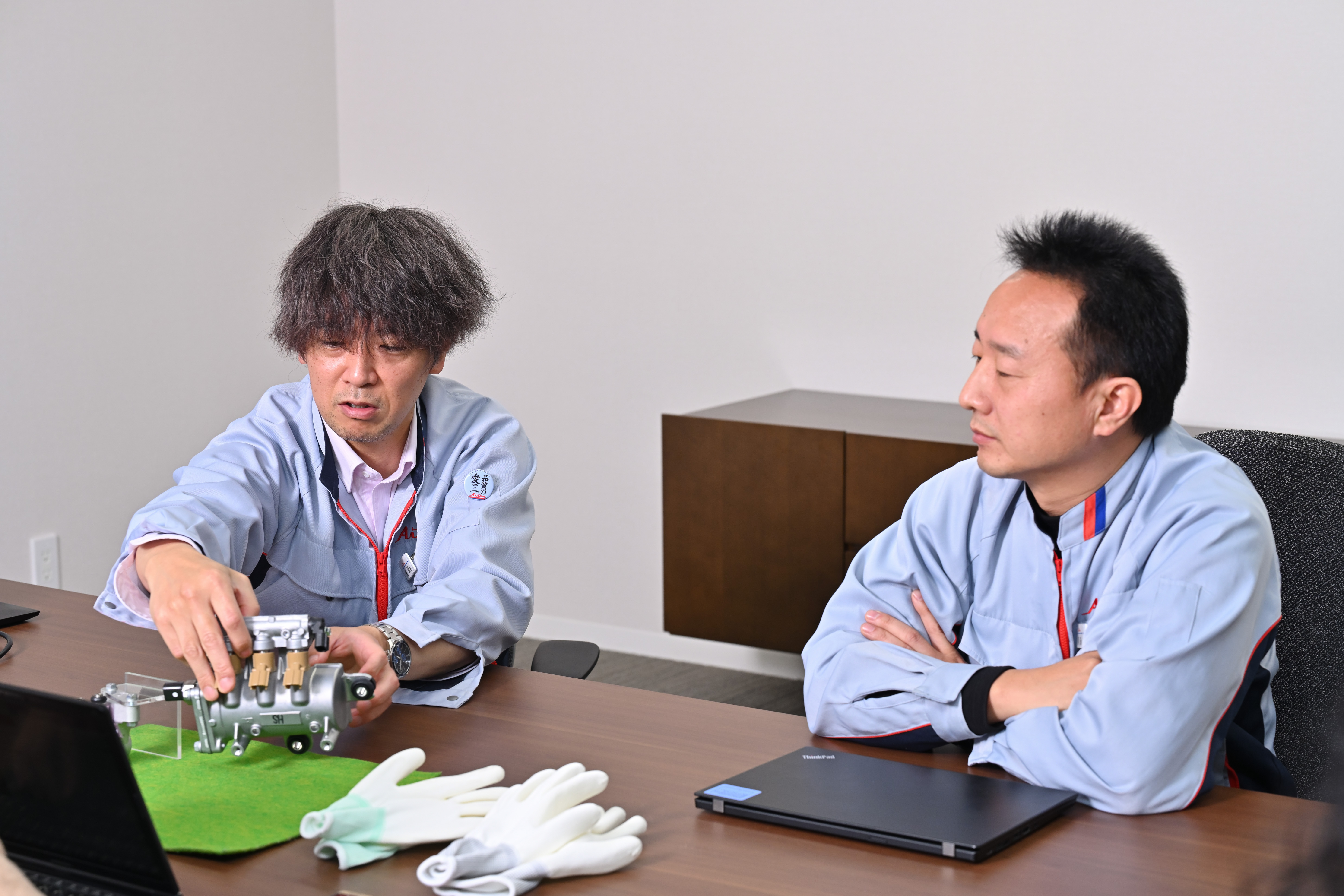 Left to right: Aisan Industry’s Masayuki Kito and Junichi Shinoda
Left to right: Aisan Industry’s Masayuki Kito and Junichi Shinoda
Kito: What led us to embark on a joint research project with AIST was our participation in a priority research project spearheaded by Knowledge Hub Aichi, which was launched by Aichi Prefecture in 2010. This is a research and development project that has been carried out through a partnership among industry, academia, and government for the purpose of resolving issues affecting key industries in the prefecture. We became interested in this project because of its connection to a theme concerning semisolid die-casting techniques.
Our company mainly produces parts through which fuel, air, exhaust gases, and other fluids can flow. Used commonly for the production of such parts is die-casting, which involves pouring molten alloy into a metal mold to be formed. The problem with die-casting is that it is prone to the generation of air bubbles when air becomes entrapped or when shrinkage upon solidification occurs during the manufacturing process. Fuel or air can then leak from the cavities that form as a result of the presence of these air bubbles.
In contrast, semisolid die-casting is a technique that is expected to minimize air entrapment and shrinkage upon solidification and thereby eliminate the formation of cavities by having a semisolid mixture of solid and liquid alloy poured into a mold. While this technique was successful when it was used with an aluminum alloy known as AC4CH in around 2000, it could not be replicated with other materials. However, ninety-five percent of aluminum alloys used in the world today are known as ADC12. Indeed, almost 100 percent of what we use is also ADC12. We thus concluded that the establishment of a technique for forming a semisolid version of ADC12 could solve issues with our products and also give rise to a technology that would surely become widely adopted in the world. The project theme originally identified by Knowledge Hub Aichi was development based on the use of semisolid techniques. Accordingly, we suggested that this project focus on ADC12 and proceeded with research and development work in this vein.
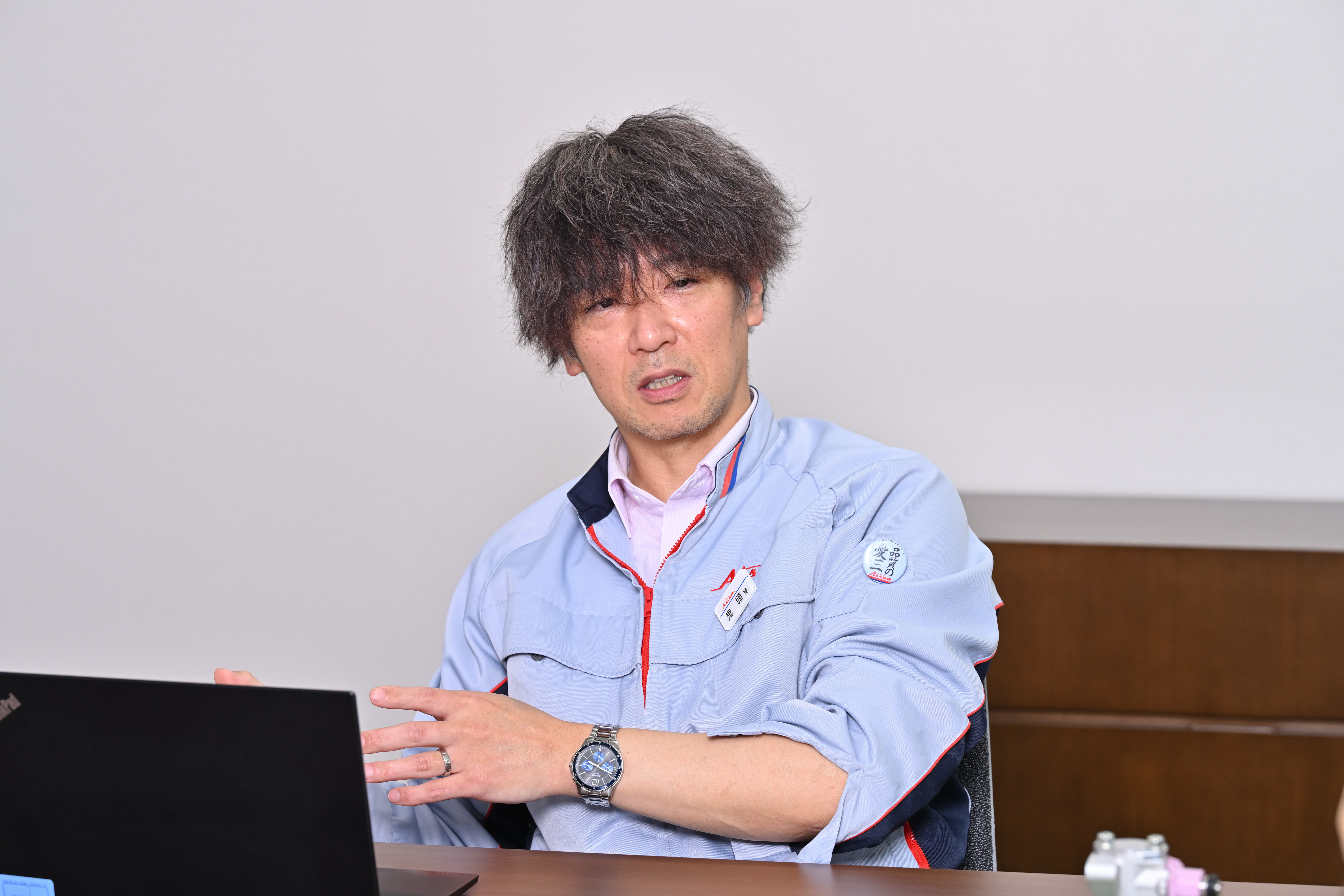
Expected of AIST was the highlighting of academic perspectives that companies do not entertain
Kito: It is a fact that the semisolid technique is something that we have been quietly researching for some time now at Aisan Industry. Unfortunately, however, we could never seem to get it right and commercialization was not in the cards at the time. With the involvement of AIST, we expected to welcome an infusion of academic knowledge. Companies can’t help but tend to prioritize the establishment of technology, such that the elucidation of the principles behind such technology can take a back seat in terms of importance. In this connection, we felt that bringing in an ethical perspective when planning research or conducting an evaluation after the implementation of the research plan could allow new results to be obtained.
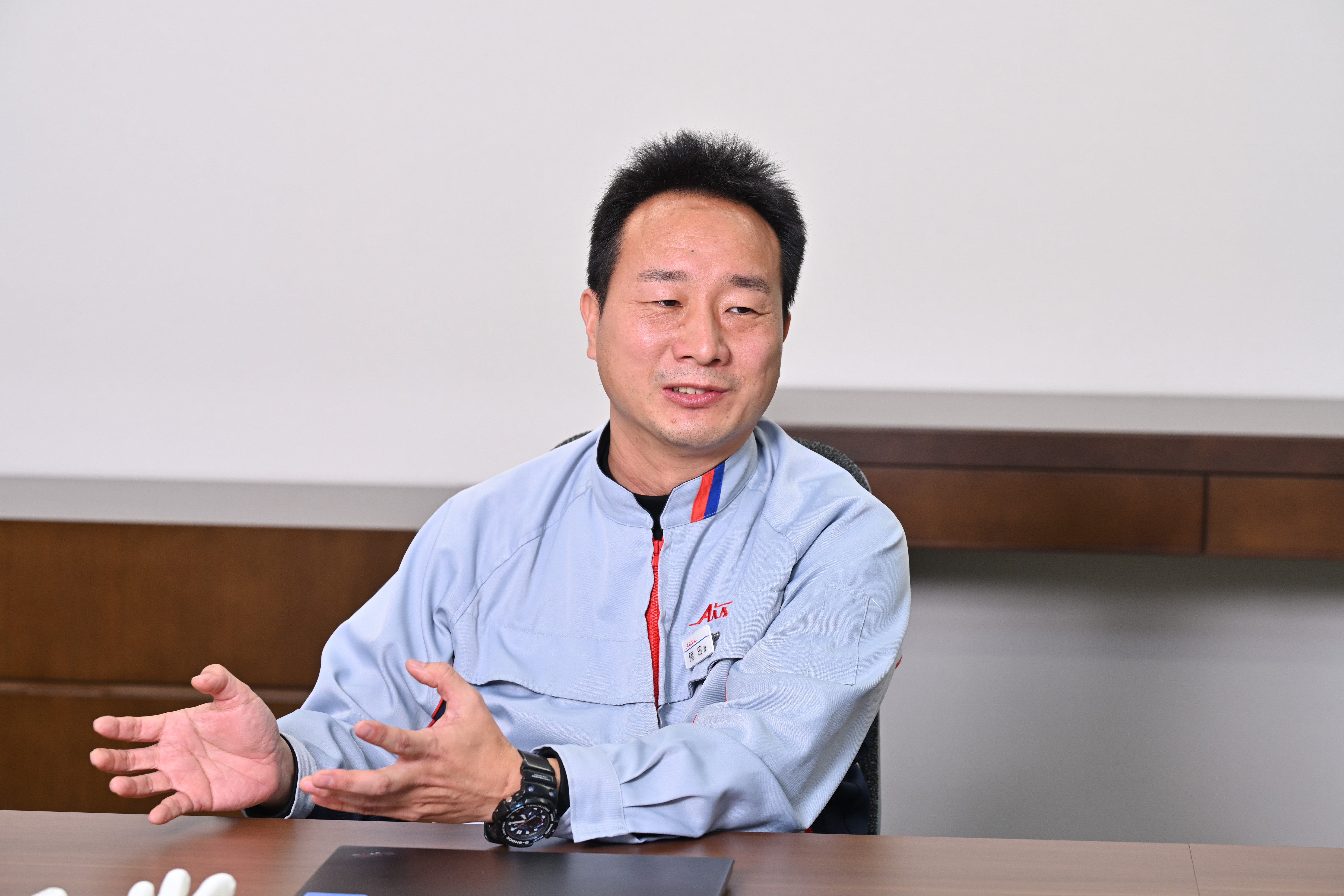
Shinoda: The fact is that, when it came to the division of roles in carrying out this research project, we were, if anything, the implementation team while AIST would evaluate what was created and summarize the research, such that this was a win-win relationship.
Kito: Knowledge Hub Aichi’s project officially began in 2011 but preliminary research had already started a year earlier. For this preliminary research, equipment to carry out semisolid die-casting with AC4CH, which was already commercially available at the time, was used as part of a basic investigation to figure out the conditions under which AC4CH would flow or the extent to which clumping would occur. Based on this investigation, we began to work on confirming what would happen if we tried to replace AC4CH with ADC12 in 2011, the first year of the project. As expected, however, we were unable to effectively make ADC12 into a semisolid state with off-the-shelf equipment for AC4CH.
The ideal semisolid state is neither too soft nor too hard. If a material is too soft, shrinkage upon solidification occurs when it is poured into a mold and allowed to harden, which then causes voids to form inside. In order to prevent shrinkage from solidification from occurring as much as possible, you need to transfer the material to a metal mold when it has solidified to a certain extent. If a material is too hard, you will find that pouring it into a metal mold is difficult, which means that you need to find just the right state in between these two extremes.
In principle then, rendering ADC12 into an ideal semisolid state will probably require greater vibrations. In this connection, we looked at various types of vibration equipment, including one that generates electromagnetic vibrations. By arranging equipment that allows us to mechanically generate vibrations, we were ultimately able – for the first time in 2012 – to make ADC12 semisolid just as we could with AC4CH, albeit in a way that produced only a small quantity of approximately 250 grams.
We then proceeded to pour semisolid ADC12 into a metal mold and evaluated the properties exhibited by the molded result. Specifically, we wanted to know how a product molded from a liquid state differed from a product molded from a semisolid state in terms of their dimensions, whether a product molded from a semisolid state really lacks voids, and how such a product differs in terms of its strength and elongation. Evaluations were conducted from various angles until the project was completed in 2015.
After the project came to an end, we brought back the results to our company and proceeded to internally make preparations for commercialization. For example, we looked into how we might incorporate vibration equipment for ADC12 into the facilities we already had and tried to figure out how strong our metal molds should be and what kind of surface treatment these molds should undergo.
We managed to achieve commercialization thanks to the foundation of joint research in which we were able to participate
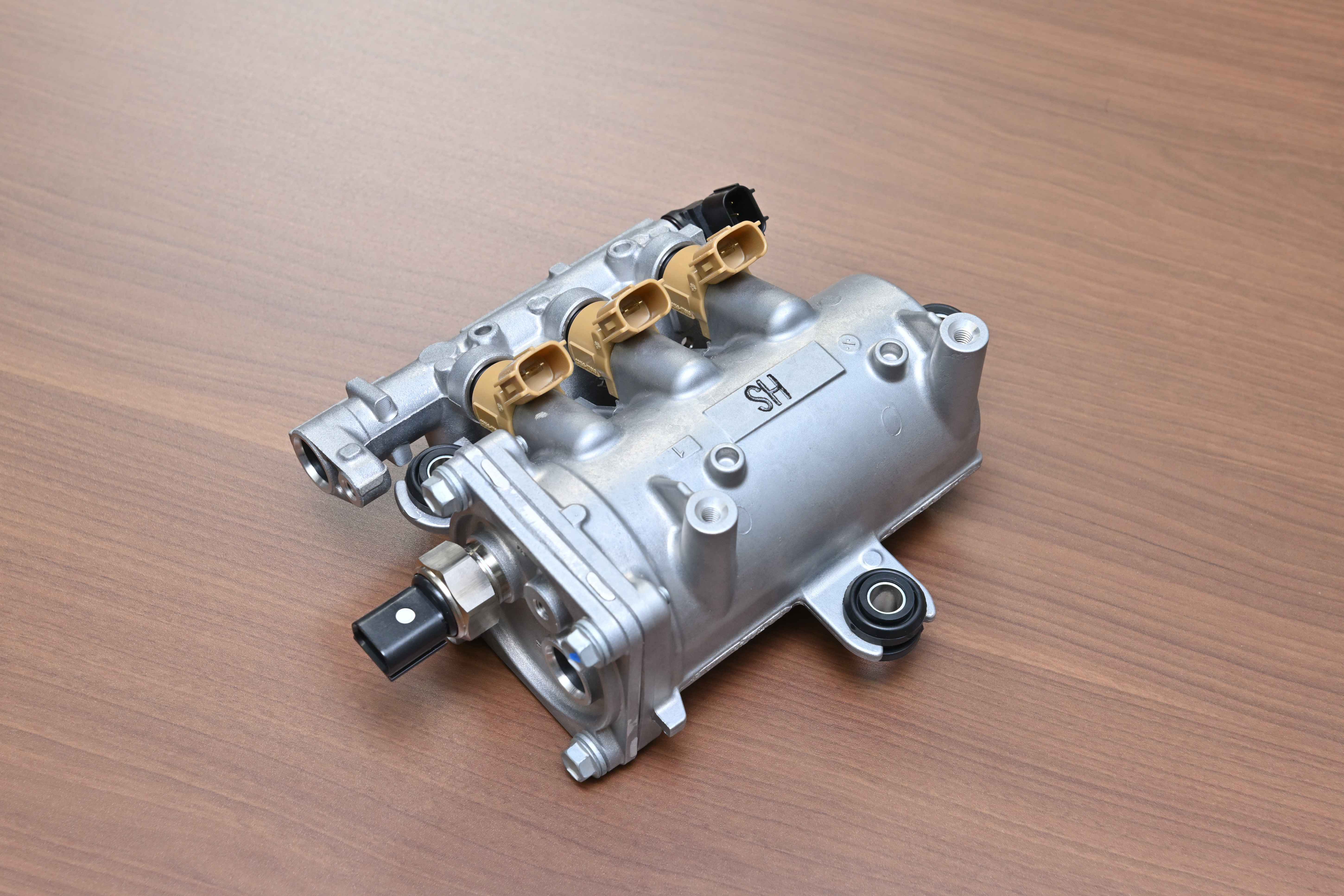 A hydrogen-supplying unit that was made by Aisan Industry with a semisolid molding technique and that is mounted in Toyota’s second-generation MIRAI fuel cell car.
A hydrogen-supplying unit that was made by Aisan Industry with a semisolid molding technique and that is mounted in Toyota’s second-generation MIRAI fuel cell car.
Shinoda: This commercialization project began in earnest in 2017. At the time, Toyota was developing its second-generation MIRAI FCEV, and they asked us whether there was a way to make a hydrogen-supply system even cheaper. In response, we proposed semisolid die-casting as a cost-effective technique.
Kito: The hydrogen-supply system in the first-generation MIRAI was made with a technique known as forging. That said, hydrogen’s molecular weight is small, which more easily allows for gas leaks, such that conventional die-casting, which is more prone to the formation of voids, is not applied. Forging is a process whereby a lump of material specially intended for use with forging is fitted into a die and pounded into the desired shape to produce a product that lacks voids. Since complex forms cannot be forged, however, the functions of a product made by forging will invariably entail the existence of unnecessary parts that cause the weight of the product to increase. Since machining is needed to create necessary channels for functional purposes, the costs for this step constitute another issue to be addressed.
On the other hand, the semisolid technique allows for the high-precision manufacturing of complex forms, such as fine gas channels, achieved simply by pouring the material into metal molds, which means that costs are lower, and the resulting product is lighter than it would be with forging since machining is not needed. Whereas forging requires thermal treatment due to the characteristics of the material, the use of ADC12 alloy, whose strength is exceptional, since the material renders thermal treatment unnecessary, such that manufacturing a hydrogen-supply system using the semisolid technique reduces the weight and cost of the product by 40 percent and 80 percent, respectively, compared to what can be achieved with forging. Energy consumption during the manufacturing process can also be reduced by 30 percent for greater energy efficiency. Since machining and thermal treatment are no longer needed, the lead time for manufacturing has been shortened. Consequently, hydrogen-supply systems made using the semisolid technique came to be commercialized for and mounted in second-generation MIRAI cars beginning in December 2020.
Shinoda: I believe that the strengths of AIST were a huge factor behind our success in commercializing our product. The ADC12 semisolid technique is a completely novel technology that has never before been seen in the world. It is natural for clients to anxiously wonder whether it is a technology that is actually viable in practice. In this connection, I have dispelled this sense of anxiety on the part of clients by explaining the theory underlying the technology while inviting them to take a look at a paper written by researchers belonging to AIST. Once the prototype for this product was actually made, we repeatedly conducted evaluations of actual products in order to meet the requirements of clients and were able to have them adopted.
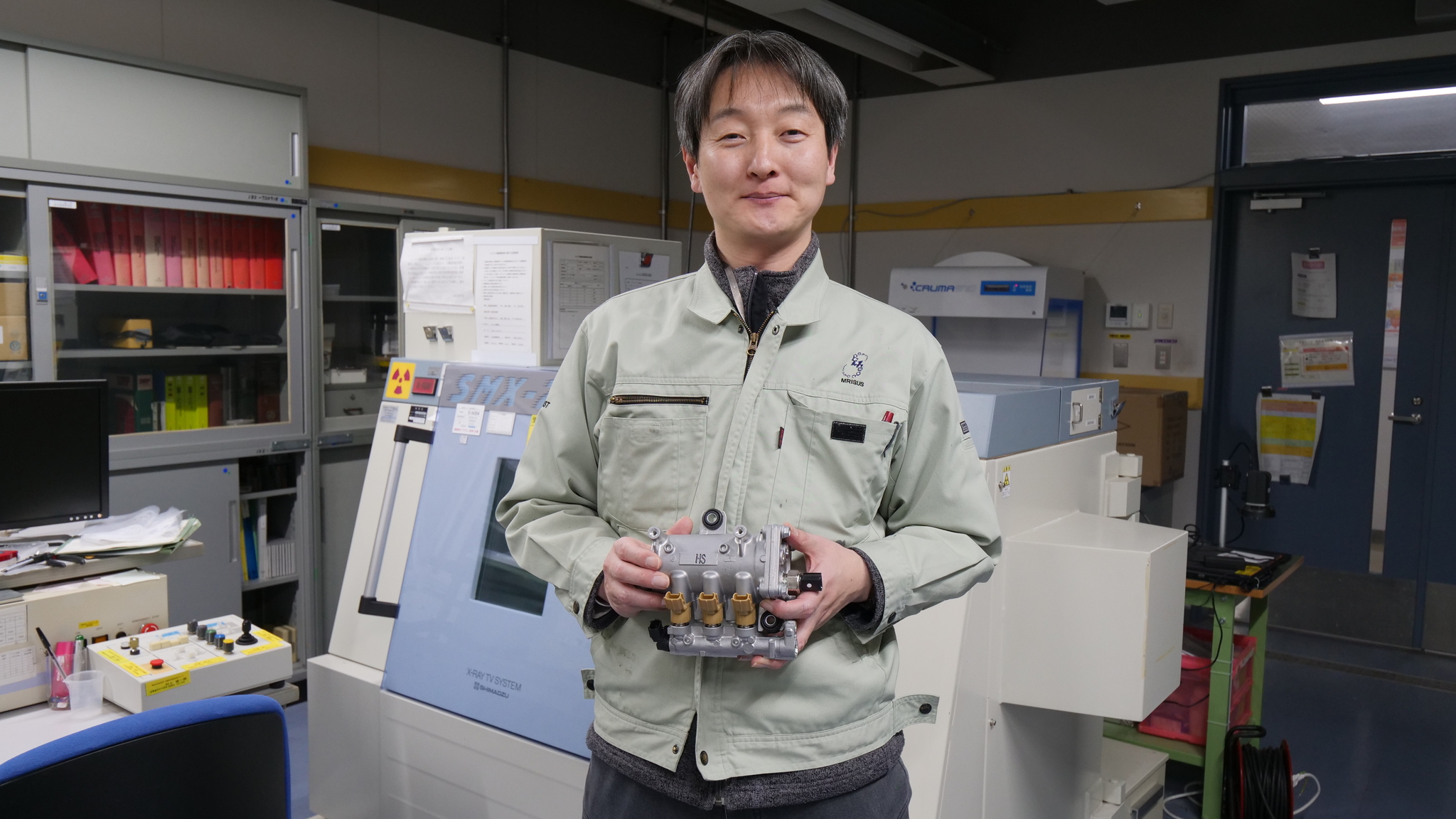
Yuichiro Murakami, Lightweight Metal Process Group, Multi-Material Research Department
Chubu Center, National Institute of Advanced Industrial Science and Technology (AIST)
We would like to proactively pursue a partnership if another opportunity were to arise
Shinoda: What I felt was great about engaging in joint research with AIST was that this arrangement allowed us to focus on research. Since we could delegate the paperwork to the person in charge at AIST, we could fulfill our own role. Incidentally, the research was carried out in a borrowed room at the Industrial Research Center in Kariya City, Aichi Prefecture. The ability to physically be present in an environment different from our company also significantly helped us to concentrate on our research.
Kito: The fact that Knowledge Hub Aichi’s priority research projects conform to a fixed development period provides another impetus to our research. Unless we can validate the theory underlying the technology in a given period of time, no results will be forthcoming, nor will commercialization be on the table. That we succeeded on these counts during the development period was thanks in no small part to our partnership with AIST’s researchers. It would have been an extremely challenging task for us to take on by ourselves.
Shinoda: In terms of some of the detailed points regarding the research, we were able to learn a new method for evaluating the structure of the semisolid state, which allowed us to evaluate the structure in greater detail.
Kito: While products made using the ADC12 semisolid technique thus far consist only of a hydrogen-supply system produced for CEVs, we expect to see demand for our products rise as the number of FCEV models and number of FCEVs shipped both increase. Demand for FC ships and trucks will no doubt also expand in the future as well. Since the equipment and facilities required for the manufacturing process have never previously existed and have to be designed and operated on our part, problems that we cannot foresee at this time will surely arise. I would like to see us continue to make improvements, strive to increase durability, and lay down the groundwork for mass production in light of these considerations.
While this joint research project as concerns the semisolid technique for ADC12 has come to an end, I would love to proactively engage in another partnership with AIST, a leading research institute in Japan, if the opportunity to do so were to arise. In order to prevail over the competition as a manufacturer, we need to develop advanced technologies that do not yet exist. The Elemental Development Office, which I head, is a section that develops truly novel techniques and methods. I want to pursue development work while incorporating knowledge and insight as generously shared with us by AIST and a host of other outside research institutes and universities.
